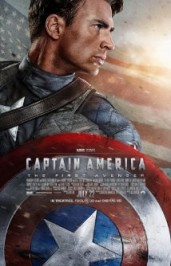This post takes a different turn from others on this blog. I want to explore something Dr. Webber mentioned during his SXSWedu panel last month. When looking at movies as historical documents, it’s important to keep in mind that their temporal setting makes a difference. Looking back on a historic film reveals nuances from when the film was made and truths about the current moment, so temporally shifted works can be particularly difficult to decode. Movies made in 2010 about 1970 are confusing: are they telling us what people thought in 2010, what people thought in 1970, or what people in 2010 thought about society in 1970? Captain America: The First Avenger (2011) provides a particularly difficult case study.
In the film, Red Skull harnesses an incomparable energy source called the Tessaract to fight Allied forces during the Second World War. It’s a cube with seemingly unrestricted powers that are reminiscent of the capabilities of nuclear energy. The film’s producer confirmed this artifact is based on the Cosmic Cube and the Infinity Stones from the comic book series. Here’s where the temporal arrangement gets tricky.
Captain America: The First Avenger is set in the early 1940s during the Second World War. The source material was published at that time as the first run of the Captain America comic book series. The Cosmic Cube first appeared in 1966, and the Infinity Stones debuted in 1976-1977. This film’s screenplay was first drafted in 2007, but not finalized until 2010.
As such, the Tesseract in the film can mean several different things. If evaluating from its predecessors’ debut in the 1960s and 1970s, the Tesseract represents widespread optimism about the future of atomic energy as advocated by nuclear enthusiasts of the era. However, at the point the screenplay was written, the same resource is represented as destructive and dangerous, especially in the wrong hands, which reveals how nuclear sentiments have changed. Looking back on the film and its representations of energy from the present moment reveals just how much our views of energy have changed.



 Hydropower Saves The Fugitive
Hydropower Saves The Fugitive